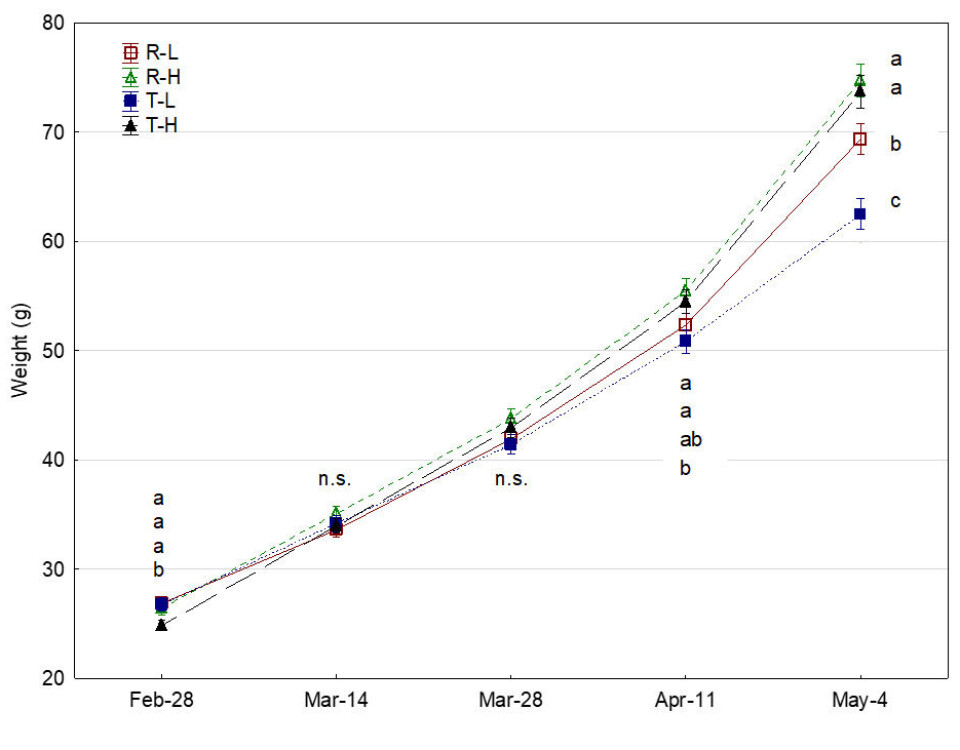
The effect of two rearing systems and water exchange rates on growth, welfare and robustness of juvenile lumpfish
Cleaner fish welfare has become a serious concern due to reports of high mortalities and disease outbreaks in salmon farms. It has been reported that lumpfish can lose body condition within the first six weeks of transfer to sea cages, suggesting that conditions throughout production and deployment are not optimised enough to ensure the transfer of healthy strong lumpfish to sea cages.
However, there has been little focus spent on how commercial rearing conditions of juvenile lumpfish affect their robustness and performance in hatcheries, as well as potential carryover effects once transferred to sea cages.
Earlier research at FISK in Tromsø found that rearing lumpfish in raceway systems may produce more robust individuals with higher condition factor when transferred to Atlantic salmon sea cages, and body condition has recently been suggested as an operational welfare indicator for lumpfish.
Previous research has recommended studying the optimal water current speed or water exchange rates for lumpfish juvenile production to optimise robustness and performance. To this end, this study compared how different rearing systems (circular, raceway) and water exchange rates (low, high) in the hatchery affects growth, stress, skin and gill health in juvenile lumpfish. In addition, potential carryover effects on performance at sea were investigated by studying growth, condition, and welfare of the same fish in small scale sea pens.
Study details
Experimental trials were conducted to investigate how lumpfish growth, condition factor, skin and gill mucus activity, cortisol, and serotonin activity were affected by rearing in two systems (tank (T), raceway (R)) and two water exchange rates (high (T-H): 1,350 litres per hour (L h-1); (R-H): 780 L h−1 and low (T-L): 450 L h−1; (R-L): 260 L h−1) during a 66-day laboratory trial. Furthermore, potential carryover effects on performance at sea were investigated by studying growth, condition, and welfare of the same fish in small-scale sea pens
Results
Lumpfish in the R-L group had 10% higher growth compared to the T-L group. However, at the higher water velocities (R-H and T-H), growth was highest in the tanks (figure 1). Final weight was similar for R-H and T-H due to larger start weight for R-H.
In the follow-up trial in sea pens, the fish in the T-H group were significantly larger at the start of the sea pen study and lumpfish in the T-L group were the smallest. This trend continued throughout the study period with the lumpfish in the T-H group having a significantly higher mean weight and lumpfish in the T-L group having the lowest mean weight at the end of the study (data not shown).

Fish reared in raceways had significantly higher baseline plasma cortisol levels and elevated values of brainstem serotonergic activity compared to fish reared in tanks (figure 2). Higher baseline cortisol levels in fish can indicate sub-optimal rearing conditions. The levels observed in both raceways and those with high water exchange were comparable to previously observed cortisol levels in lumpfish exposed to mild acute stressors.
Independently of water exchange rate, the form of rearing unit affected brainstem serotonergic activity significantly, with elevated values in fish reared in raceways compared to fish reared in tanks (data not shown).

There was a significant increase in mucus parameter values in the skin (mucous cell area, volumetric density, and defence activity) from the first to the second sampling in April in all groups. However, there was a decrease in mucus parameter values in the skin in the Tanks groups from April to August. The skin of lumpfish in the R-H group in August had mucus cells with a high volumetric density in large numbers.
There was a significant increase in mucus parameter values in gills from the first sampling in February to the sampling on 21 April, in all groups. Subsequently, there was a statistically significant decrease in mucus parameter values in gills from 21 April to August in all groups. Gills of lumpfish in the R-H group had more mucus cells with high volumetric density (defence activity or barrier status) in August (data not shown).
Independently of water exchange rate, rearing unit form affected brainstem serotonergic activity significantly, with elevated values in fish reared in raceways compared to fish reared in tanks (figure 3).
![Figure 3: Brain stem serotonergic activity (100 x [5-HIAA]/[5-HT]) in juvenile lumpfish reared in shallow raceways (R) or circular tanks (T). Mean values which do not share a letter were found to be significantly different (Student–Newman–Keuls post hoc test, P < 0.05).](https://image.landbasedaq.com/1943221.jpg?imageId=1943221&width=960&height=654&format=jpg)
Discussion / Conclusions
A combination of tanks and low water exchange rates (T-L) produced significantly smaller lumpfish, with significantly lower specific growth rate, and lower condition factor.
Based on the significantly smaller size, slower growth rate and a condition factor below the threshold which represents acceptable fish welfare in lumpfish, rearing of juvenile lumpfish in tanks at the low water exchange rate (150% exchange of tank water per hour) is considered sub-optimal compared to exchange rates of 450% in tanks and 200% or 600% in raceways.
The rearing conditions in the different tank designs at the hatchery stage did not seem to affect fish welfare during the subsequent stage in sea cages.
The stress indicators, plasma cortisol, and brain serotonergic activity indicates higher stress level in raceways and at higher water exchange rates (450% and 600%) independent of tank design. However, these effects are not reflected in negative growth response as fish at high water exchange in both tank designs showed the fastest growth. Despite large individual variation in the mucus cell parameters, there was an indication of lower defence activity in skin mucus cells in raceways at high water exchange compared to tanks at high water exchange, suggesting that raceways at high water exchange may have more favourable environmental conditions.
The rearing conditions in the different tank designs at the hatchery stage did not seem to affect fish welfare during the subsequent stage in sea cages.